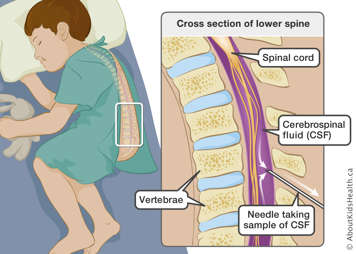A lumbar puncture is a procedure used to obtain a sample of cerebrospinal fluid (CSF). The CSF is studied to determine if there are tumour cells in the CSF. In some cases, the CSF is also studied to measure the levels of two proteins, alpha-fetoprotein (AFP) and human chorionic gonadotropin (HCG), that are produced by a certain type of tumour called a germinoma or germ cell tumour. The CSF may also be cultured to look for bacterial growth.
Other names for a lumbar puncture include spinal tap, spinal puncture, thecal puncture, and rachiocentesis.
Most often children have an intravenous sedative to have a lumbar puncture. Some older children may take laughing gas instead.
If your child is sedated, they will need to stop eating and drinking sometime before the sedative is given. Your treatment team will let you know when your child needs to stop eating and drinking. Your child will have the following monitors attached if they are sedated:
- blood pressure cuff: to keep track of blood pressure
- electrocardiogram (EKG or ECG) monitors: to show how the heart is working
- oxygen saturation clip: placed on the finger to keep track of how much oxygen the red blood cells are carrying
Your child will have a cream put on their lower back to make the area numb. EMLA (Eutectic Mixture of "Local Anaesthetic") is one brand of this type of cream. Some older children choose not to have any sedation, but will have the EMLA cream put on. They may also choose to have additional local anaesthetic injected into the back.

Your child's back will be cleaned and then a fine needle will be inserted between the bones (vertebrae) of the spine. A sample of fluid will be withdrawn. Drugs can also be injected through the needle if they are needed. The fluid is then examined in a laboratory to see if there are tumour cells.
Your child will need to lie down for an hour or so after the lumbar puncture and will be monitored by a nurse.
If your child had a sedative, they may be sleepy, grumpy, and unsteady for four to six hours. Please check on your child carefully for about six hours after the test. Give your child only small sips of clear liquids such as water or apple juice. Your child may have a regular meal if they feel like eating. When your child is fully awake, they may return to their usual activities.